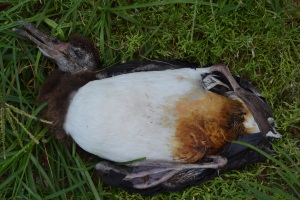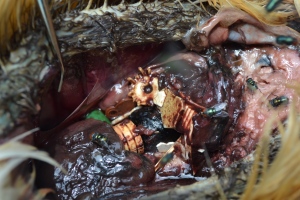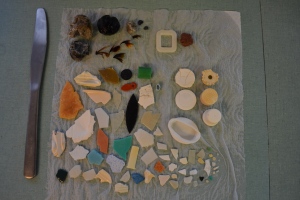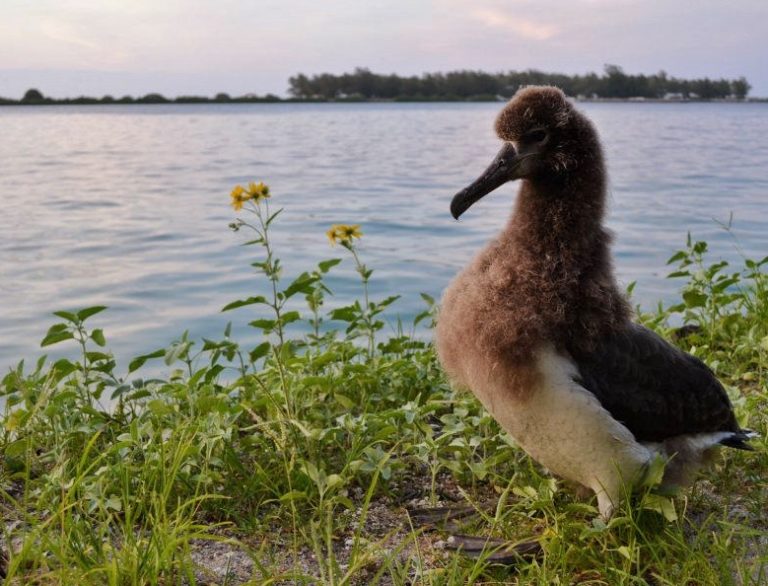Midway Reality Check
Hey all!
Three weeks in and I’m still surprised at how fast/slow/weird the time acts here. Some days feel like they’re never going to end and other times, I’m still trying to figure out how it got to be Friday already. Every day is an adventure and brings something new!
The highlight of this week by far was our Monday afternoon project. It was sad, exhilarating and most of all…totally eye-opening. Allow me to explain:
A little over a week ago, all us volunteers were out in the field, finishing up our task of banding Laysan Albatross chicks before they fledged. Banding chicks started out being kind of frustrating but with a steep learning curve, we’ve quickly become pros. Plus…snuggling downy, fluffy albatross is kind of the coolest thing ever. 😉 Jen, a volunteer who’s been here for 3 months and is pretty much a master bander, was in the process of banding one particular chick and while doing so, it pooed blood. Cause for concern? You bet, but since there’s nothing that she could do, she let it be.

Well, on Monday, as Jen was surveying that same albatross plot to record band numbers, she happened upon that same bird, only this time…it was dead. As a disclaimer, finding a dead albatross on Midway is not something that’s surprising or even unexpected. During the course of our work day, it’s not at all uncommon to come across at least 10 dead birds – these guys only eat every 8-10 days and it’s HOT here. That combo is not exactly the most favorable. But I digress. What made this dead bird particularly interesting was that a) it had pooed blood 6 days prior and 2) when Jen came across the carcass, its entire lower breast region was covered in blood. Hm…
After talking to our boss, Pete, he hypothesized that the chick probably died from internal bleeding due to a puncture wound and his guess was that plastic did the puncturing. When we heard that, our immediate response was, “Necropsy, please!” And so, after lunch on Monday (post-lunch necropsy…mmm…) we took the bird out of the field and opened it up. Ahem: Pete cut the bird open (thanks, Pete!) and let us eager volunteers (read: Liz, Jen and myself) do the digging.
Three things about working with a carcass:
1) They start to smell really bad after sitting out in the open air for a few days.
2) Determining cause of death is nearly impossible when all of the internal organs have turned to mush – another reason why fresh carcasses are ideal.
3) There are so, so many flies.
Despite these setbacks, we persevered. I know, I know: get to the good part! What did we find? Take a wild guess:

Yep, you guessed it. Plastic: lots of it. 73 pieces* to be exact and that’s only counting the pieces we could find among the decaying mess. Most of the fragments were larger than the size of a quarter and fairly sharp but there were also quite a few micro-plastics (smaller than a fingernail). According to Pete, this albatross was actually carrying a lighter load of plastic than he’s seen in the past. I didn’t know whether to be relieved or sickened by that.
*Full disclosure: we did find 10 additional pieces of natural items in the body cavity including squid beaks, pumice and a piece of bone, bringing the total to 83 pieces of material. Still, 90% plastic is not a percentage I like, not one bit.

This was just one bird. Looking out over the scads of chicks that cover almost every inch of available surface on this island, it was hard not to think that there are probably a lot more like this one. Our waste is escaping into the environment and having a harsh impact on creatures that do not possess the ability to shy away from it. What kind of legacy is that? Not one that I want to carry on. Thanks for the reminder, Midway.


Devastating.